Butterfly Valves
Butterfly valves are devices used to regulate the flow of liquids and gases within pipelines. They offer full shut-off functionality by utilizing a disk that pivots on a shaft, which is connected to a lever handle or wheel for control. When the actuator is turned, the disk rotates to a vertical position, blocking the flow path, as opposed to lying flat and allowing the flow to pass through the pipe.
History of Butterfly Valves
Butterfly valves date back to the 1870s and have undergone significant advancements since then, particularly in the number of valves in a disk and the mechanics of opening and closing the disk. Throughout the 20th century, these valves evolved to improve the speed of rotations and allowed for more precise control of engine speed.
Historically, the design of butterfly valves included an opener and closer, along with two springs in the electric actuators and a moving armature connected to the engine. Modern electric actuator engines typically incorporate hydraulic adjusters to ensure proper valve sealing. In pneumatic actuator engines, air flowing through the coil generates a force on the valve, overcoming the compressive spring and friction forces. These springs are adjustable, ensuring the right tension for any armature position between the opener and closer. The springs are preloaded to facilitate quick response times while minimizing electrical energy consumption. During regular operation, the spring forces in the electric actuators help accelerate the moving parts, while the electric forces attract the armature—a remarkable advancement in the evolution of butterfly valves.
Benefits and Advantages of Butterfly Valves
Butterfly valves offer several advantages and disadvantages when compared to other types of flow control devices. They are efficient at blocking flow and typically do not result in leakage. However, they can be challenging to clean thoroughly, making them unsuitable for applications that require sterility, such as those in the food or medical industries, although sterile metals like stainless steel are sometimes used.
One of the benefits of butterfly valves is their ease of operation. A 90° rotation of the handle results in a complete closure or opening of the valve. Larger valves are usually equipped with a gearbox, where a gear operator connected to a handwheel is linked to the valve stem. This design enhances operation, but it does come at the expense of speed.
In terms of cost, butterfly valves are generally inexpensive to manufacture. Due to their design, they require less material, making them more economical than many other valve types. The wafer-type butterfly valve, which fits between two pipeline flanges, is particularly cost-effective. The lug wafer butterfly valve design, on the other hand, is secured between pipe flanges by bolts that pass through holes in the valve’s outer casing.
Butterfly valves also require less space. Thanks to their compact design, they take up less room compared to other valve types.
Another advantage is that butterfly valves typically require less maintenance than other types of valves.
Butterfly Valve Design
Butterfly Valve Design
The design of a butterfly valve is crucial in controlling the flow of fluids through a piping system. The butterfly style utilizes a circular vane or disc as the shut-off mechanism. These valves feature a quick opening and closing quarter-turn function to regulate the flow of liquids or gases.
How a Butterfly Valve Works
Typically, butterfly valves pivot on an axis that is perpendicular to the flow direction inside the flow chamber. They are mounted on a spindle, which allows the valve to control flow in a single direction. Butterfly valves are often used as throttling devices, enabling control over flow levels when in completely closed, fully open, or partially open positions.
Suppliers of butterfly valves stock a variety of closure types and body configurations to match the flow control requirements and design specifications. Butterfly valves come in various diameters, allowing for different flow rates. Smaller assemblies are used in areas where space is limited. Innovations in fabrication techniques have made these valves more precise, ensuring smooth and even metal surfaces with minimal internal stresses. Bolt holes and flanges are carefully crafted to meet valve standards, ensuring they do not become weak points, while the assembly of the seal, disc, and shaft undergoes thorough testing before installation.
Materials Used in Butterfly Valves
To ensure that these valves meet the stringent requirements for potable water, the materials used must be sanitary and safe. The ability to work with a wide range of substances allows butterfly valves to be purchased by industries across various sectors. Manufacturers typically use three main materials in constructing these valves:
- Plastic: The least common material for butterfly valves. The body and disc are made from thermoplastic materials, molded into a one-piece design. Plastic valves are cost-effective but should not be used with harsh chemicals that can degrade the disc, leading to poor sealing.
- Stainless Steel: Known for its resistance to corrosion and oxidation, stainless steel is a preferred material for butterfly valves. It requires less maintenance, has a longer lifespan, and is easy to clean, making it ideal for food and beverage industries and applications involving drinkable liquids.
- Cast Iron (Ductile Iron): Used in heavy-duty applications, cast iron butterfly valves are durable due to the casting process that hardens the iron, making it very resilient in demanding conditions.
Butterfly Valve Components
The design of butterfly valves has remained largely the same since their inception, though advancements in materials, machining, and fabrication processes have improved performance. The essential components of a butterfly valve are:
- Body: The body of a butterfly valve typically fits between two pipe flanges. The most common designs are lug and wafer bodies.
- Disk: The disk functions similarly to a plug in a plug valve, a gate in a gate valve, or a ball in a ball valve. The design and orientation of the disk are varied to enhance flow, sealing, and reduce operating torque.
- Stem: The stem can be a two-piece (split-stem) or a one-piece design, depending on the specific requirements of the application.
- Seat: The seat uses an interference fit to provide a seal between the disk edge and the body. The material used for the seat can be made from various elastomers or polymers. The seat may be pressed, locked in, or bonded to the body.
Size of Butterfly Valves
The properties of steel and iron alloys, including how they perform under various pressures, temperatures, and substances, have been extensively researched to ensure reliable performance when butterfly valves are installed in pipelines. CNC (Computer Numeric Controlled) machining techniques have enabled manufacturers to produce discs and enclosures with very precise measurements, resulting in tight fits and minimal clearance. With the availability of a wide range of sizes, butterfly valves can be made to standard or custom specifications, making them suitable for use across many industries.
Butterfly Valve Images, Diagrams and Visual Concepts
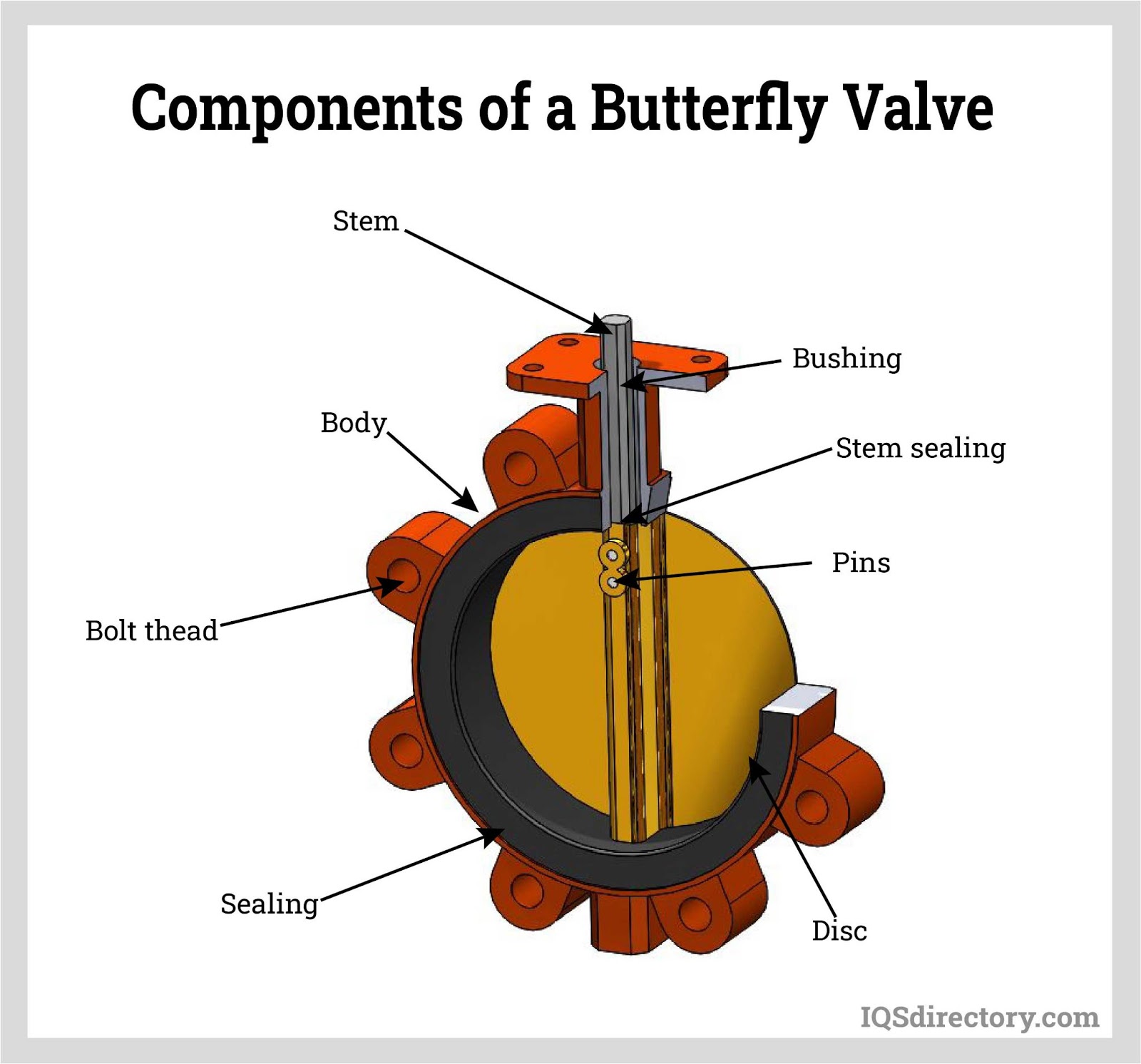 The main components of a butterfly valve.
The main components of a butterfly valve.
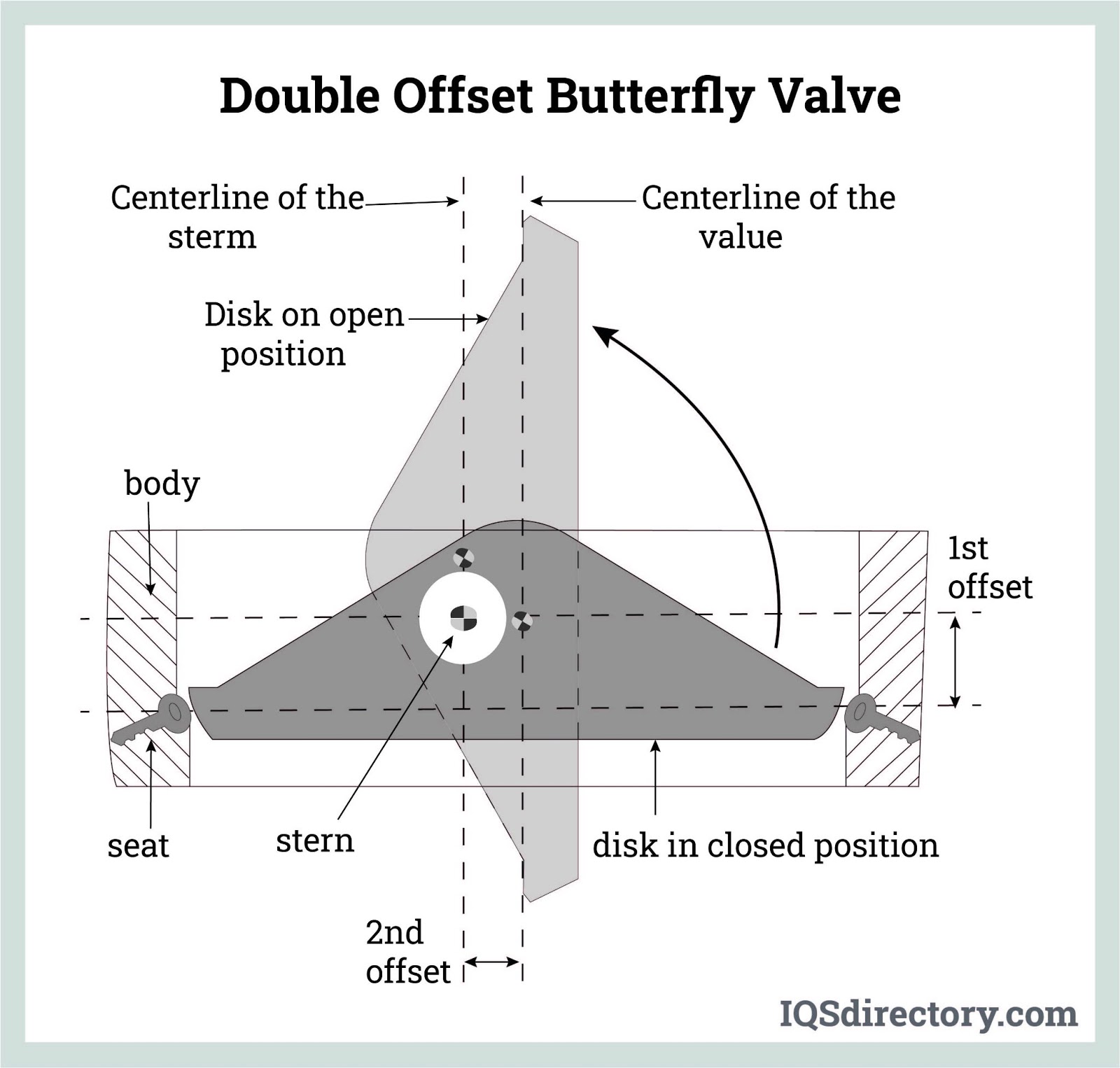 Double-flanged butterfly valves have a pair of flanges built on each side of the valve body.
Double-flanged butterfly valves have a pair of flanges built on each side of the valve body.
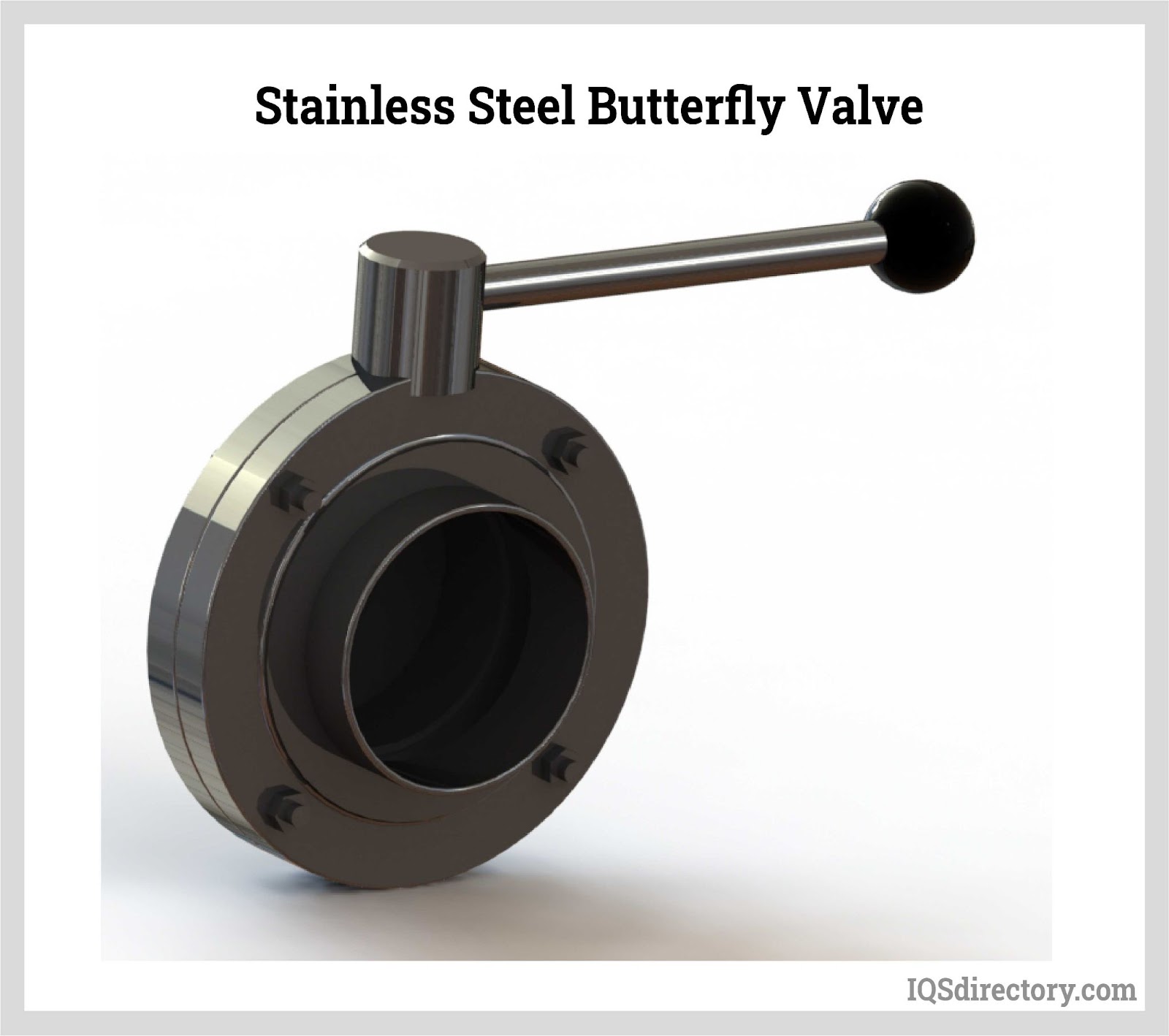 Metal butterfly valves have high toughness and withstand intense pressure.
Metal butterfly valves have high toughness and withstand intense pressure.
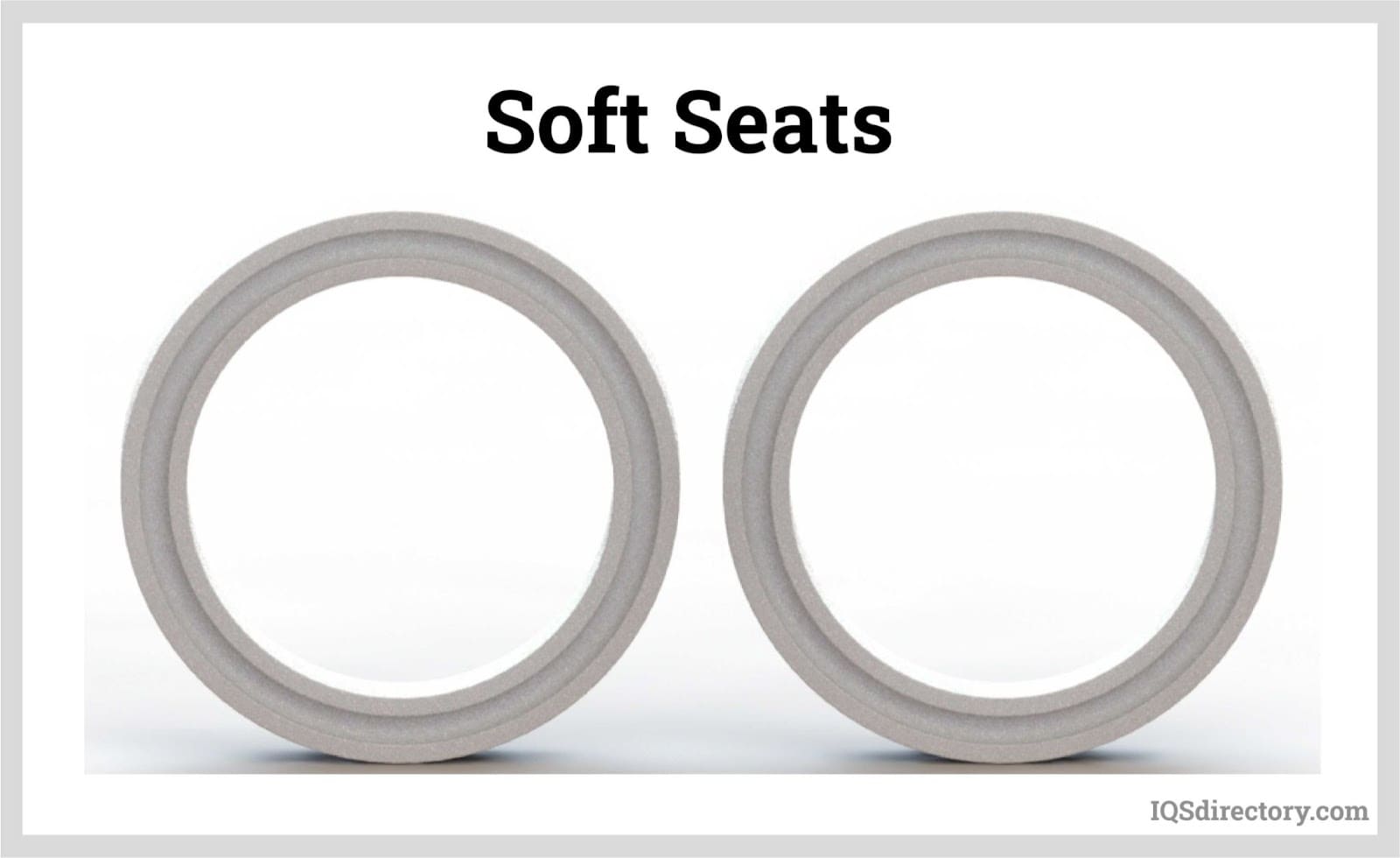 Softs seats are made from plastic or elastomeric materials with a low coefficient of friction and have self-lubricating properties.
Softs seats are made from plastic or elastomeric materials with a low coefficient of friction and have self-lubricating properties.
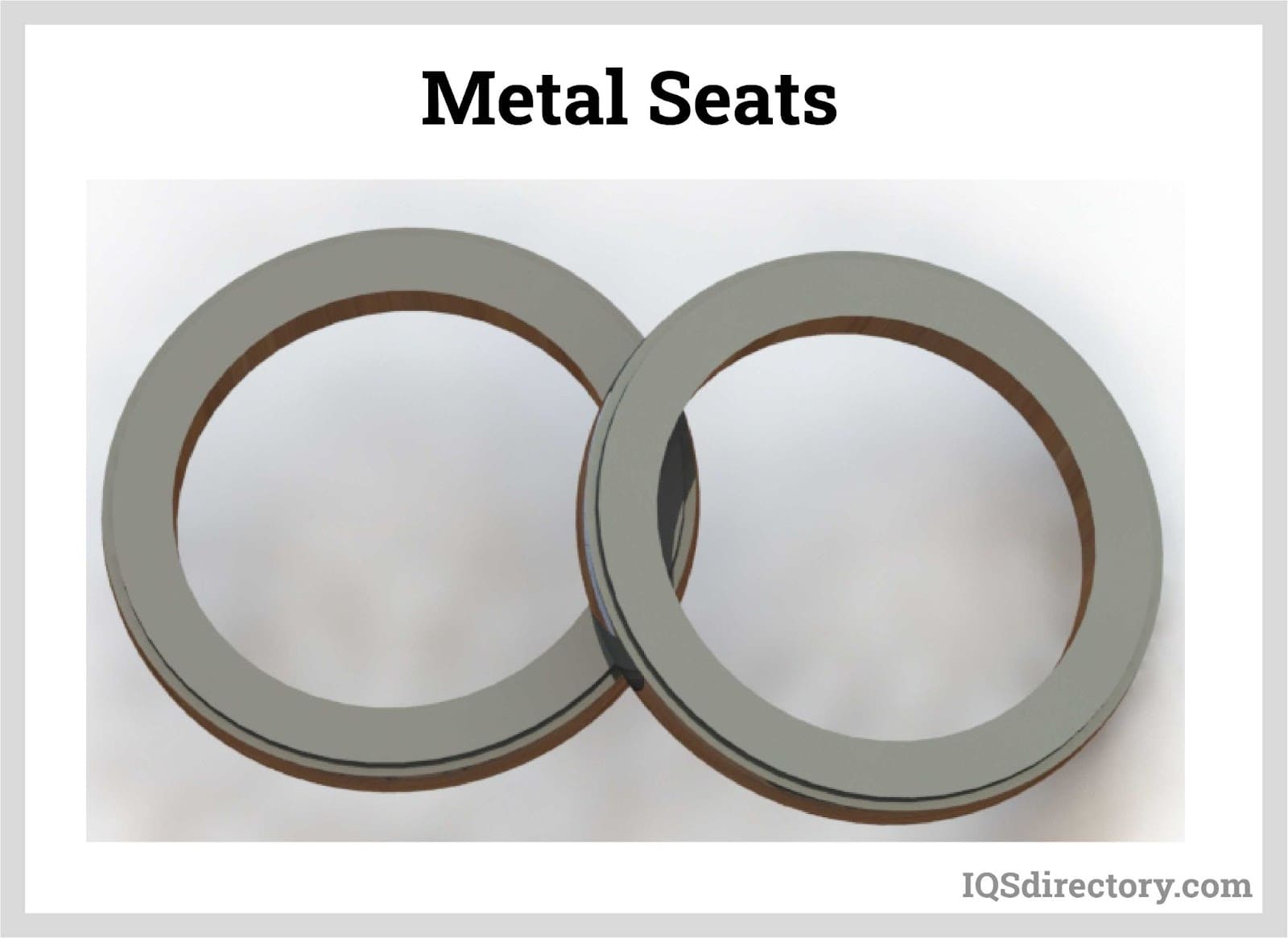 Metal seats can withstand and retain their strength at high temperatures.
Metal seats can withstand and retain their strength at high temperatures.
Butterfly Valve Types
-
Aluminum Butterfly Valves
Made from various grades of aluminum, these valves are known for being ultra-lightweight and strong. However, unlike stainless steel, aluminum is more susceptible to corrosion over time.
Awwa Butterfly Valves
Designed to meet the standards set by the American Water Works Association, these valves are specifically used for transporting potable water.
Cast Iron Butterfly Valves
Ideal for heavy-duty applications in harsh environments, cast iron butterfly valves are known for their strength and durability.
Electric Butterfly Valves
These valves operate with an electric actuator to open and close the valve, eliminating the need for a manually operated lever or crank wheel.
Flanged Butterfly Valves
Featuring raised outer rims, flanged butterfly valves can be easily installed between two pipes. This design allows one side to be disconnected without disrupting the entire piping system.
High Performance Butterfly Valves
Typically double offset valves, these valves can endure both high temperatures and pressures, making them suitable for demanding environments.
Lug Butterfly Valves
Lug butterfly valves have threaded metal inserts in the bolt holes, allowing the system to use two sets of bolts without the need for nuts. Installed between two flanges, these valves allow one side of the system to be disconnected without disturbing the other side.
Plastic Butterfly Valves
These valves are more affordable and offer greater flexibility compared to their metal counterparts. However, they typically have lower maximum pressure and temperature stability.
Pneumatic Butterfly Valves
These valves are used to shut off pipes that transport compressed or pressurized air.
Stainless Steel Butterfly Valves
The most common type of butterfly valve, stainless steel valves are valued for their strength and corrosion resistance.
Triple Offset Butterfly Valves
These valves are mounted eccentrically in three places, helping to create a tighter, stronger seal.
Wafer Butterfly Valves
Installed between two flanges, wafer butterfly valves are secured using bolts, nuts, or studs, offering a simple and effective design for many applications.
Installing Butterfly Valves
Installing butterfly valves may be more advantageous than gate valves for several reasons:
- Butterfly valves are lighter and require less space, making them ideal for compact installations.
- Compared to gate valves, butterfly valves have much smaller dimensions, which makes them suitable for tight spaces.
- Butterfly valves open fully faster and are easier to shut off, typically requiring only a quarter turn.
- The shorter shafts of butterfly valves can provide better accessibility, potentially leading to fewer complications.
- Butterfly valves are generally more cost-effective, as they require fewer materials and weigh less.
Applications for Butterfly Valves
Butterfly valves are widely used across various environments because they can control the flow of fluids without completely shutting off the pipe. They can manage the flow of gases such as air, liquids like water or petroleum, and mixtures of solids such as slurries.
Specific applications of butterfly valves include chemical transport, underground piping systems, high-pressure water lines, and carburetors. Industries that use butterfly valves include pipe fabricators, automotive, waterworks companies, irrigation sectors, food processing, and industrial manufacturing.
These valves are commonly used in food transport and chemical plants where precise control of product flow is necessary. They also have applications in HVAC, petroleum recovery, and industries dealing with high-pressure water. Butterfly valves serve a wide range of purposes, including:
- Air, cooling water, gases, and fire protection systems
- Slurry and similar services
- Vacuum service
- High-temperature and high-pressure water and steam services
- Compressed air or gas applications
Valve Standards and Specifications
Valves, including butterfly valves, are used in a wide range of applications across industrial, commercial, and residential sectors. To ensure proper functionality, compatibility, and safety, several major regulatory organizations oversee the design, manufacturing, and usage of these valves.
The key standard organizations include:
- American Petroleum Institute
- American Society of Mechanical Engineers
- American National Standards Institute
- ASTM International
- Manufacturers Standardization Society
These organizations are headquartered in the United States but have international influence and are recognized globally.
For engineers designing or using valves for global applications, it is important to review the standards and documents provided by national standard organizations, such as:
- International Organization for Standardization (ISO)
- European Committee for Standardization (CEN)
- ANSI Valve Standards (United States)
- BSI Valve Standards (United Kingdom)
- CSA Valve Standards (Canada)
- DIN Valve Standards (Germany)
- EEMUA Valve Standards (United Kingdom)
- JSA Valve Standards (Japan)
Things to Consider When Purchasing a Butterfly Valve
Most industrial companies that use butterfly valves are in manufacturing, chemicals, water-based industries, or any field involving piping systems. Depending on the size and shape of the pipe where the butterfly valve will be installed, manufacturers may need to create custom-designed butterfly valves. These manufacturers must take into account the material properties and fabrication techniques for each valve component.
When dealing with high or low-pressure environments, specific types of butterfly valves are required, just as different piping connections may require particular designs. It's important to find butterfly valve companies that can design, engineer, and manufacture valves tailored to your exact specifications. Whatever the piping needs, there is a butterfly valve to meet them.
Browse our website to explore and discover top butterfly valve manufacturers with detailed product descriptions and roll-over ads. Connect with these companies through our easy and efficient request-for-quote form. We provide company profiles, website links, locations, phone numbers, product videos, and more. You can also read reviews and stay updated with the latest product articles.
Whether you're searching for manufacturers of stainless steel butterfly valves, high-performance butterfly valves, or triple offset butterfly valves, IQS is your premier resource.
Butterfly Valves Terms
-
Actuator
The component of a valve that converts electrical, fluid, or thermal energy into mechanical energy to open or close the valve.
Aeration
The process of mixing air with a high oxygen content into a liquid. In carburetor butterfly valves, aeration occurs when oxygen is mixed with fuel.
Back Pressure
The force exerted on the upstream side of a butterfly valve or valve seat.
Bearing
A support used in conjunction with butterfly valves to hold the revolving shaft in its proper position.
Blind Flange
A solid plate-like fitting used to seal the end of a flanged pipe.
Bonnet
The part of a valve that connects the valve body to the actuator. The bonnet may also include the stem packing.
Breakaway (Unseating) Torque
The force required to rotate the closure element of a butterfly or rotary valve.
Flange
The rim at the end of a fitting, pipe, or valve that allows for bolting onto another pipe or fitting.
Flow Meter
A device used to measure and display the flow rate of a material.
Flow Rate
The weight, mass, or volume of a gas, liquid, or solid passing through a medium per unit of time.
Gate Valve
A type of valve similar to a butterfly valve, but not used for throttling applications, as it is either fully open or fully closed.
Inlet
The area of a valve through which fluid enters.
Leakage
The amount of fluid that passes through a valve when it is in the off position. Leakage is typically measured in volume per time.
Outlet
The opening in a valve through which fluid exits.
Pounds per Square Inch (PSI)
A unit of measurement for the pressure of a liquid, solid, or gas in a valve system.
Recovery
The amount of pressure reduced in a flow stream due to the design of the control valve. Recovery is also described as the ratio of maximum downstream pressure to upstream pressure.
Seating Torque
The turning force needed to close a valve.
Slip on Flange
A flange that slides over the end of a pipe and is then welded in place.
Throttling
The regulation of flow or current through a valve.
Trim
The inner parts of a valve that come into contact with the flow stream.
Valve Body
The main part of the valve that contains passages for the flowing material.
Variable Speed
A term describing an actuator’s ability to provide a slower operating time across its full range of operation.
Vena Contracta
The area of a valve where the flow stream is slowest, typically located downstream of the physical constriction.

